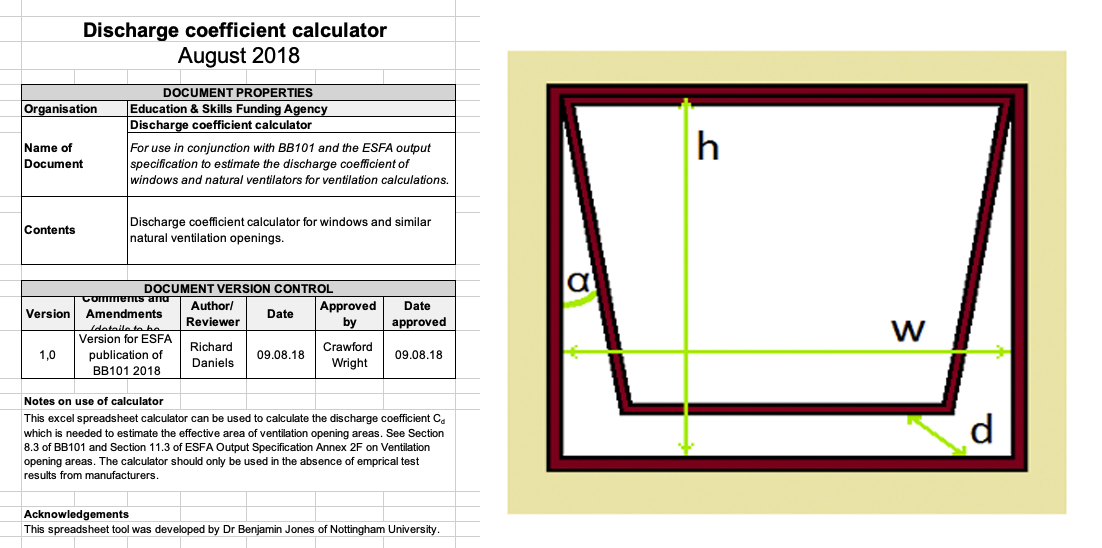Discharge coefficients, free, effective and equivalent areas

|
| https://www.gov.uk/government/publications/classvent-and-classcool-school-ventilation-design-tool |
Contents |
[edit] Introduction
The terms free area, effective area, equivalent area and discharge coefficient are similar, and can at times be poorly, incorrectly or mistakenly calculated. This has the potential to become increasingly significant as the impacts of climate change and the need for adaptation increase.
The Building Regulations Part O comes into force from June the 15th 2022, and refers to all three terms, requiring their consideration in meting the requirements of the approved document Part O.
[edit] Free area
Free area (Afree) is the geometric open area of a ventilation opening. It is quite simply the height and width of the opening multiplied to give the open area. W x H = A or Afree. 'This area assumes a clear sharp-edged orifice that would have a coefficient of discharge (Cd) of 0.62'
[edit] Effective area
Effective area (Aeff) is the area through which air flows after the resistance of airflow has been taken into account. The effective area is the free area described above multiplied by the discharge coefficient (Cd). Afree x Cd = Aeff. The discharge coefficient includes the angle of the opening as one of its factors.
[edit] Equivalent area
Equivalent area (Aeq) is a measure of the aerodynamic performance of an opening. It is the area of a sharp-edged circular orifice through which air would pass at the same volume flow rate, under an identical applied pressure difference, as through the opening under consideration. This is the effective area divided by the orifice discharge coefficient (Cd0) which assumes a clear sharp-edged orifice would have a coefficient of discharge (Cd) of 0.62. or Aeff / Cd0 = Aeq)
[edit] Discharge coefficient
In practice, a constant value of discharge coefficient is often used for simplification, this is basically a ratio of the actual discharge to the ideal discharge. However, a constant value of discharge coefficient can lead to deceptive airflow estimations in different window designs.
[edit] Orifice discharge coefficient
The orifice discharge coefficient (Cd0) is somewhat more accurate and gives a figure for a specific window considering also the slope or angle of plane and other adjustments.
[edit] Recommended tool
The buildings regulations recommend using a tool to assist in assessing these figures when it comes to the simplified method of Part O. The tool is referred to as the 'discharge coefficient calculator ' and was written in 2018 as part of the guidance on school design that formed BB101.
The simple tool can be downloaded here: https://www.gov.uk/government/publications/classvent-and-classcool-school-ventilation-design-tool
[edit] Related articles on Designing Buildings
Featured articles and news
One of the most impressive Victorian architects. Book review.
RTPI leader to become new CIOB Chief Executive Officer
Dr Victoria Hills MRTPI, FICE to take over after Caroline Gumble’s departure.
Social and affordable housing, a long term plan for delivery
The “Delivering a Decade of Renewal for Social and Affordable Housing” strategy sets out future path.
A change to adoptive architecture
Effects of global weather warming on architectural detailing, material choice and human interaction.
The proposed publicly owned and backed subsidiary of Homes England, to facilitate new homes.
How big is the problem and what can we do to mitigate the effects?
Overheating guidance and tools for building designers
A number of cool guides to help with the heat.
The UK's Modern Industrial Strategy: A 10 year plan
Previous consultation criticism, current key elements and general support with some persisting reservations.
Building Safety Regulator reforms
New roles, new staff and a new fast track service pave the way for a single construction regulator.
Architectural Technologist CPDs and Communications
CIAT CPD… and how you can do it!
Cooling centres and cool spaces
Managing extreme heat in cities by directing the public to places for heat stress relief and water sources.
Winter gardens: A brief history and warm variations
Extending the season with glass in different forms and terms.
Restoring Great Yarmouth's Winter Gardens
Transforming one of the least sustainable constructions imaginable.
Construction Skills Mission Board launch sector drive
Newly formed government and industry collaboration set strategy for recruiting an additional 100,000 construction workers a year.
New Architects Code comes into effect in September 2025
ARB Architects Code of Conduct and Practice available with ongoing consultation regarding guidance.
Welsh Skills Body (Medr) launches ambitious plan
The new skills body brings together funding and regulation of tertiary education and research for the devolved nation.
Paul Gandy FCIOB announced as next CIOB President
Former Tilbury Douglas CEO takes helm.






















